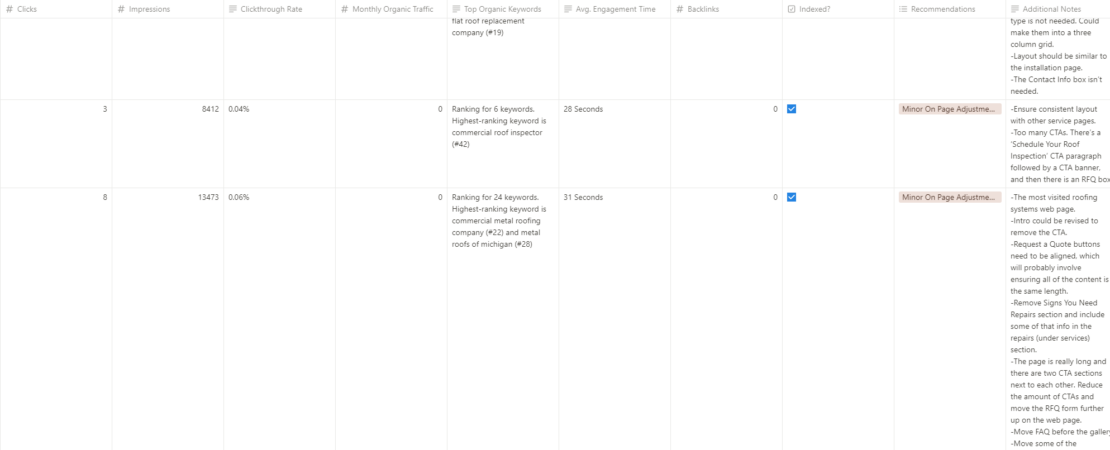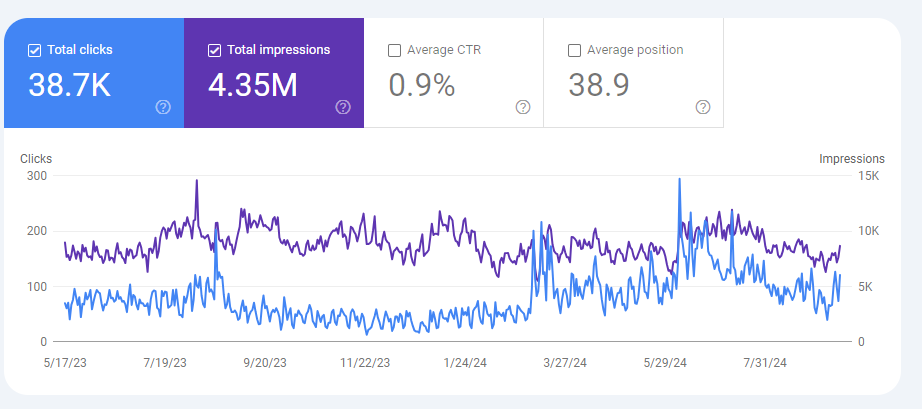Performing a Content Audit for the First Time: Tips & Tricks
If you regularly create content either for your own business or for another client, audits should be something that you integrate into your existing processes.
For one, it can help you identify potential duplicate content. I’ve seen so many businesses just churn out content nonstop, and you know what happens? There are at least five blog posts that cover the same topic.
Content audits can also help you determine what’s working and not working with your content and whether potential content pieces could be repurposed. Repurposing content (versus creating brand-new content) can definitely help you save time and money, especially if you’re working with little to no resources.
I personally like to perform content audits for Momentum’s clients annually, but you could perform them bi-annually, especially if you have a larger, in-house team that can help you. The big thing is ensuring that the content has enough time to perform. Don’t expect to publish a content piece and see immediate results a month later. Give it about three to four months to perform. Anyway, I digress (which I often do)—let’s talk about how to perform a content audit.
Creating the Spreadsheet
First, where are you going to record it? We use Notion in-house, so I created a content audit template there. Before we switched to Notion, I used Google Sheets. It honestly doesn’t matter what type of software you use to create the spreadsheet; I won’t tell you how to live your life.
However, there are some things that I recommend that you have in your spreadsheet:
- The title of the content you’re auditing
- What type of content it is
- Content topic (optional, but can be especially important in scenarios where a client offers a ton of products or services. Recording the content topic can help you identify areas where content is scarce)
- URL of the published content
- The content’s publish date
- Meta title and meta description
- Areas for key metrics (I’ll get into those in the next section)
- Information on whether it’s indexed
- How the content was created (AI, human, etc., We’ll talk more about that later on)
- Information on whether the content is orphan/there isn’t internal linking
- A notes section where you incorporate your recommendations
Additionally, in Notion, I have a separate property/tab for my recommendations so I can set filters by recommendation, which can be helpful if I’m just looking for a list of which content pieces I recommended for removal, which ones I recommended for rewriting or repurposing, etc.

That’s really all there is to it. The hardest part is going through every individual content piece.
Metrics
The metrics you record will vary based on your overall goals. So, at Momentum, our primary focus is SEO. You may not be in the same boat, so I will provide additional recommendations on other metrics/KPIs you could include.
Here are the ones that I typically analyze in an audit:
- Clicks
- Impressions
- Clickthrough Rate
- Monthly Organic Traffic
- Leads
- User Engagement
- Top Organic Keywords (remember—more keywords aren’t necessarily better. Look at the actual quality and relevancy of the keywords. Are these even keywords that you or the client care about?)
- Monthly Views/Visits
- Number & Quality of Backlinks (yes, please look at backlink quality; more backlinks=not always good)
Determine Your Goals Before You Evaluate Metrics
When I perform the audit, I want answers to these questions:
- How often is the content being seen and interacted with?
- How engaged do users seem?
- What is this ultimately doing for the client? Improving search visibility? Garnering leads?
- How is the content performing compared to our competitors writing on similar topics?
And more importantly, don’t just use these metrics and run off with them. I don’t know your business and your goals. When you’re performing audits, you need to tailor them based on your specific objectives. So, before you decide which metrics to evaluate, consider these questions: What do you hope to get from the audit? What type of information do you want to know? Once you have the answers, you can go from there.
Additional Metrics
As promised, here are some additional metrics you could evaluate:
- Social media shares or reposts
- Social media likes or reactions
- Reader comments
- Email open rates (if the content is being shared in an email marketing campaign)
- Images within the content and their corresponding alt text (especially important if you want to improve content accessibility)
- Page speed (Momentum performs separate speed audits every month, so I intentionally exclude this metric from my content audits)
Tools for Pulling Metrics

There are simply too many tools out there to name, and they all claim to be the best, so I’m instead just going to focus on the tools that I use for my content audits:
- Google Search Console: GSC makes it very easy to see clicks and impressions of indexed pages, and I don’t have to calculate clickthrough rate, yay!
- Google Analytics 4: This “well-loved” tool can actually be pretty good for pulling page reports once you figure out how it works. For content audits, I mostly use it to analyze overall engagement and traffic sources.
- Ahrefs: I use Ahrefs to analyze backlinks, keyword rankings, and estimated organic traffic based on the keywords the content ranks for.
- WhatConverts: I use this to look at client leads and where each lead came from.

Screaming Frog can also be good at identifying duplicate URLs, although I don’t use it frequently.
If you’re really into social media and email marketing, I’ve used Hootsuite in the past, and it’s been pretty decent at providing metrics that you could potentially use in content audits. Again, use the tools that you have—these are just the ones that I use.
Analyzing the Content
I hate (or maybe love) to break it to you, but you can’t just record content metrics and call it a day. Evaluating metrics is only half of the content auditing process; the next part is looking at the content itself and determining its usefulness and relevance to the reader.
Google has very extensive guidelines that their Quality Search Raters use. You can definitely look through these and use them to guide you when determining your content’s overall quality or usefulness. However, the guidelines are 170 pages long, so you better brew a cup of tea first.
If you want a more concise version, check out these questions that I ask myself when I’m looking at the content:
- Based on the H1, what would I expect the article to be about? Does the actual content meet those expectations?
- Does the overall flow of the content, including the heading structure, make sense?
- If there is a question being posed in the content title, is it answered relatively soon in the content itself? How straightforward is the content? Is there “filler” or “fluffy” content that could be removed?
- How are images being used? Do they add to the overall experience at all? Does the alt text actually describe the image, or is it just a keyword-stuffing nightmare? Are there any broken images?
- Are the headings too vague? Do they accurately set up what the reader should expect from the body of content underneath it?
- Who is the intended target audience?
- Is the tone/overall voice right for the target audience? And is the content at the target audience’s reading level?
- How is internal linking used within the article? Could it be improved? Are there missing opportunities? Do the links even work?
- What’s the call to action at the end of the content piece? Does it make sense?
- Would this content perform better in a different format, such as an infographic?
- Is there missing information that the reader may want to know? (Sometimes, the ‘missing information’ is simply the information I, as an inquisitive reader, think is missing. If I’m not sure, I look at what competitors are doing. You don’t necessarily want to copy them, but it’s important to understand what other content pieces cover).
- Does the meta title/meta description accurately summarize what the article is about?
- How old is the content? Is there outdated information in the article? (Hint: If you have statistics in a content piece, be prepared to update it every one to two years).
- Are there inaccuracies? (This one may be challenging to identify, which is why I recommend partnering with subject matter experts FIRST before you create content).
- Is the content even relevant to what the client does? If not, why is it here?
- What is the overall focus keyword of this content? Is the content ranking for that keyword? Are there better keywords that could be targeted?
- What is the ultimate goal of this content piece?
I think…phew, that’s it. If this is overwhelming to you, focus on one question first after you look at the content: As a reader, do you feel satisfied by what you just read? If not, maybe it’s time to look at improving the content somehow.
Tracking the Content Source
When I write “content source” I’m referring to who (or what) wrote the content. I feel that this is going to be incredibly important moving forward, so I’ve decided to make this a separate section.
When auditing now and in the future, I recommend tracking content created by real human writers and ones created with AI tools.
Do you notice a difference in performance when you analyze the content? Google has said in the past that it doesn’t necessarily care about how the content is created, but it does care about quality.
If you’ve noticed a significant difference in performance between content written with AI and content written by actual writers, you might want to consider the following:
- Before content is even created, make sure it’s structured in a way that makes sense to the reader
- Ensure any information you provide your AI tools comes from a subject matter expert. With AI, the output is only as good as the input. If you feed it something generic, it will give you something generic. Feed it facts and other details provided to you by an expert; that way, you don’t have to worry (as much) about quality or inaccuracy issues. Additionally, if you frequently create YMYL content, please, please, please (cue Sabrina Carpenter) avoid using AI unless an expert is giving you information to work with and/or they’re reviewing the content.
What I Avoid
Focusing on Word Count
When I audit content, I sincerely do not care about word count. I’m actually quite tired of on-page analysis tools telling me that my content is too short and needs to be longer. When people focus too much on word count, they end up with weird content that doesn’t end up saying anything meaningful. So, repeat after me: I do not care about word count. I only care about the content effectively covering the topic and giving the reader the information they need.
If you can do it in 400 words, cool. If it takes 1,000 words to get it out, OK. I really don’t believe there is a “sweet spot” for words.
Freaking Out Over Backlinks
I’m going to backpedal a little bit here—I still think backlinks matter and can help content, but I also believe we shouldn’t put backlinks on a pedestal. It’s fine to have them, and even better if they’re from a reputable source, but please don’t ever think: This content doesn’t seem relevant, but it has 15 backlinks, so maybe I’ll keep it. No. If it’s not useful to the reader and irrelevant to what you or your client does, don’t keep it!
Rushing Through the Process
Audits are meant to take time. If you rush through them, you’re not really getting anything out of them, are you? Understand from the beginning that they will take a while to complete. Maybe pick a nice playlist or album to listen to—I recommend In the Court of the Crimson King.
When I provide estimates to my co-workers, I usually tell them it will take me about 10-15 minutes to evaluate one piece. That includes reading and analyzing the overall usefulness of the content and recording the metrics. So, if you have 60 blog posts you need to audit…you can do the math.
If you’re not prepared to take this time or don’t have the time, I’m sorry, but you just shouldn’t be auditing at this moment.
Other Tips
- If you recommend removing a content piece, find a suitable redirect first. If there isn’t one, don’t sweat it, especially if the content isn’t indexed or if it’s about a product or service the client no longer offers. Remember—redirects still need to be relevant to the reader. Please stop redirecting to the homepage.
- When you pull data from different resources, use the same date/time range to ensure consistency. This is especially important if the audit is going to take multiple weeks to complete.
- Don’t be biased. If you wrote a content piece yourself and it’s underperforming, deal with the facts and identify what could be improved.
- If you’re sharing audit findings with a client, keep them brief. As you can probably tell from this post, I get very excited at the prospect of writing and reading giant paragraphs. Clients may not be as excited. In 1-2 sentences, tell your clients what your recommendations are and why for each content piece.
- Perform audits for new clients that already regularly have content on their website. If you’re in SEO like Momentum and get a new client with 30 pages worth of blogs, there is absolutely no reason to create a content calendar for them from the beginning. When you take the time to analyze their content, you can identify content gaps, what type of content to avoid (to prevent duplicate content), and evaluate pieces that could be improved.
- Act on your audit findings. I know this seems obvious, but it’s so important. You did all that hard work in the audit, so move forward and improve or remove that content!
Interested in Learning More? Schedule a Consultation
Since 2010, Momentum has been building websites and managing SEO campaigns for clients in various industries. Whether you’re a business owner or a marketing coordinator at a company, our team can help you find strategies to grow your business online. That includes examining your existing content and determining how it could be improved.
If you’re interested in learning more about Momentum’s services and how we can help you, click here to schedule a consultation.
